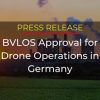US drone regulation has made slow but steady progress in approving safe, advanced drone operations. For those new to this niche topic, approving advanced commercial drone operations could look like fully autonomous power grid inspections – critical to restoring power infrastructure after a storm. Or autonomous delivery of food and medical supplies (or online shopping orders). Over the past decade, large-scale, streamlined Beyond Visual Line of Sight (BVLOS) approvals have been the “holy grail” of regulatory approvals – but they’ve always felt just out of reach. That is, until the emergence of the nationwide BVLOS approval.
BVLOS approvals transformed: from bureaucratic nightmare to zero friction
Previously, organizations would have to apply for case-by-case, site-by-site approval to operate the drones from a remote location. Applications were evaluated by the FAA individually, with the average wait time coming in at around 3 months to a year. Moreover, advanced approvals were only accessible for companies with the right resources and know-how, and even then were often granted for test purposes. Because regulatory processes were so cumbersome, many organizations would resort to using piloted drone services. These services are often costly, with limited availability and no immediate response or situational awareness.
In stark contrast, the nationwide BVLOS approval is the most advanced, large-scale operational approval ever given out by the FAA. It allows organizations to operate Percepto drones remotely from day one. The groundbreaking approval enables those organizations to leverage automated drone operations easily – without jumping through bureaucratic hoops.
The last regulatory hurdle
In the last 10 years, drone technology advancements have enabled organizations to leverage drones for frequent infrastructure inspections, deliveries, emergency response and more. But the FAA has struggled to safely integrate drones into the airspace alongside manned aircrafts. As a result, BVLOS approvals provided by the FAA as of today include personnel, usually a Visual Observer (VO), on site to deconflict the airspace, namely to guarantee the drone is not risking any other aircraft. While many commercial applications are enabled with a VO on site, such as monitoring industrial facilities, for other use cases however, such as power line or railway inspections and deliveries, the VO introduces significant operational challenges, namely additional costs, limited frequency and availability.
In response, in December, 2021 the FAA established the BVLOS Aviation Rulemaking Committee (ARC) – a committee of drone regulation stakeholders and experts tasked with recommending a streamlined path for BVLOS operations. The BVLOS ARC announcement held the promise of a rule to govern complex operations, more commonly known as the “BVLOS rule”, which would allow organizations meeting the rule’s criteria to operate BVLOS without applying for individual approvals. The BVLOS ARC made their recommendations for a new complex operations rule to the FAA, who are still working to establish the rule to streamline BVLOS approvals.
Only a handful of BVLOS waivers have been granted without personnel on site, mainly in the case of an emergency, or for testing purposes. The next step for the FAA is to provide a regulatory path forward for BVLOS operations without personnel on site – or what the FAA calls highly automated BVLOS.
The future of commercial drones and highly automated BVLOS
Highly automated BVLOS is the future of commercial drone operations. It will enable organizations (again, think power restoration, refinery maintenance, medical delivery, consumer delivery, etc.) to operate drones remotely without any personnel on site, not even a VO. For any use case, this increases operational speed and frequency, enables business continuity, and will increase the value and overall adoption of commercial drone technology.
With mature, reliable drone solutions, BVLOS ops have proven safe to operate over people and critical infrastructure. The last remaining safety concern is how to operate drones in coordination with other aircrafts, gliders and drones flying in the same airspace.
Today, we see highly automated BVLOS being approved in one of two ways:
- Technological solution – a detect and avoid solution, relying on a combination of technologies such as radars, cameras and Unmanned Aircraft System Traffic Management (UTM). This would apply to all drone operations under an altitude of 400 feet.
- Operational solution – drone flight within approximately 100 feet from any infrastructure, close enough so that no other aircraft would be operating there.
In the future, highly automated BVLOS will be accessible to all – from industry stakeholders to drone operators – under the BVLOS rule. The recommendation by the BVLOS ARC proposes that the rule will organize the national airspace such that under ~400 feet, drones, not manned aircrafts, will have the right of way. All aircrafts, manned and drones alike, would communicate their exact location via one centralized, nationwide UTM. In this proposed rule, the need for costly technological solutions or complex operational solutions would be eliminated. More importantly, such a BVLOS rule would deliver a safe, accessible and complete solution for highly automated BVLOS drone operations, unlocking the full potential of drones in our day-to-day lives.
In 2023, regulatory hurdles take their leave
For the past 10 years, the FAA has been cautiously inching forward towards streamlined highly automated drone operations. In 2023 we’ll see the fruits of their labor, with more nationwide BVLOS approvals and more highly automated BVLOS approvals. This process is the foundation for the next nationwide highly automated BVLOS approval – the holy grail we are waiting for – until a permanent BVLOS law will come into effect.





